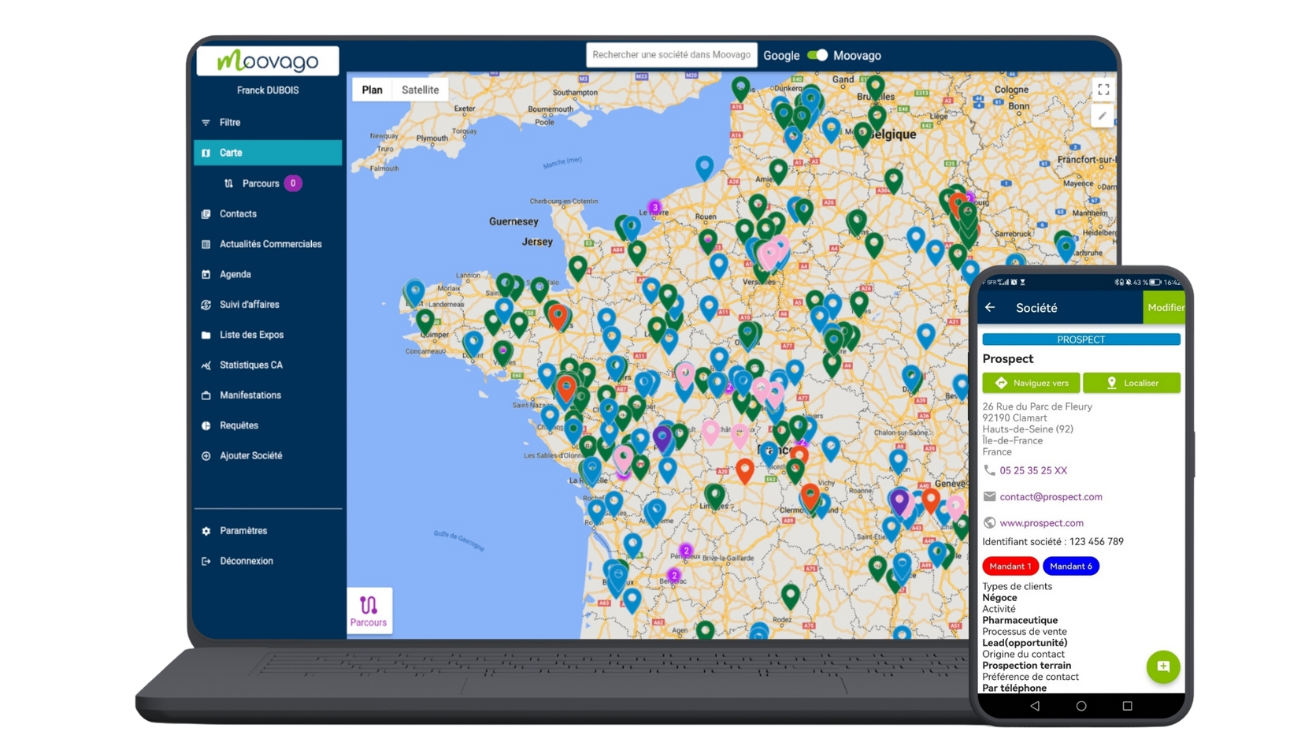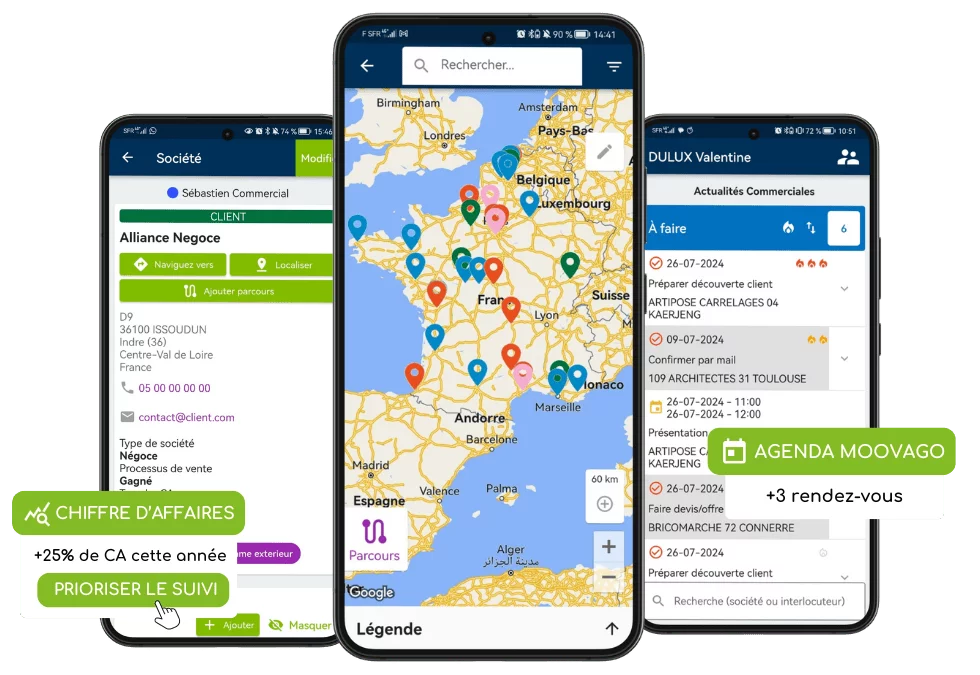Sales phoning and field visits have long been part of the salesperson’s arsenal, but optimizing their interaction remains a daily challenge for many professionals. In 2025, the challenge is no longer to choose between these two approaches, but to combine them strategically to multiply their effectiveness.
Definition of phoning
Commercial phoning, also known as telemarketing or telephone canvassing, refers to all the telephone calling techniques used by sales reps to prospect, qualify contacts, obtain appointments, follow up with customers or close sales. Unlike standardized call centers, phoning by field sales representatives is part of a personalized, targeted approach that complements physical visits.
Are you a traveling sales representative wondering how to effectively integrate phoning with your field rounds? How can you ensure that these two approaches complement each other to multiply your effectiveness? This article reveals concrete strategies for creating a winning synergy between your calls and your trips, and thus boosting your sales performance.
Sales calls and field visits: an indispensable synergy
The most successful professionals are those who know how to alternate between telephone prospecting and physical visits. This hybrid approach is a necessity dictated by changes in buying behavior and the quest for efficiency.
Why combine calls and travel?
Combining phoning and field visits offers considerable advantages for field sales representatives:
- Saving time and money: Each visit represents a cost. Phoning enables you to qualify your prospects before you travel, thus avoiding unpromising visits. A Decidento study reveals that 28% of sales reps consider the telephone to be central to their prospecting, not least for this reason.
- Densify your portfolio: By alternating calls and visits, you can manage a much larger customer portfolio. Phoning enables you to maintain contact with more prospects and customers without having to travel far.
- Acceleration of the sales cycle: Telephone follow-ups between two visits maintain the sales momentum and avoid idle time that unnecessarily lengthens the decision-making process.
- Increased responsiveness: A prospect hesitates? A question arises after you’ve been there? The telephone lets you react instantly, without waiting for your next round in the area.
According to a Hipto study, 90% of consumers are positively influenced by direct telephone conversations. This channel therefore remains a particularly effective persuasion tool, even in the digital age.
5 phoning objectives for field sales representatives
Phoning is not a substitute for field visits; it complements and optimizes them by serving several precise objectives.
1. Pre-trip qualification
Phoning is the ideal tool for assessing a prospect’s potential before investing in a visit. Ask the right questions to determine whether the visit is relevant: needs, budget, decision-making power, purchasing schedule…
2. Prepare your sales rounds
Pre-calls enable you to efficiently plan your trips according to prospects’ availability and interest. This means you can increase the density of your days in the field, visiting only qualified and available contacts.
3. Post-visit follow-up
After a visit, the follow-up call helps to maintain the momentum, answer additional questions and guide the prospect towards a decision.
Organize your day between phoning and travel
Time management is one of the key skills for field sales representatives, perhaps even more so than for office-based salespeople. Indeed, when you’re juggling phoning and field visits, time management becomes even more crucial. Rigorous organization not only allows you to optimize your output, but also to reduce the stress associated with unforeseen events and tight schedules.
How do you structure your sales schedule between visits and calls?
When it comes to organizing a salesperson’s time, there are several schools of thought.
Some sales reps prefer to focus on their phoning during dedicated blocks of time, for example with days or half-days dedicated to phoning.
In the same vein, some sales teams choose to dedicate one week a month to phoning (but also to other administrative tasks such as training, round preparation, etc.), and spend the rest of the time in the field, focused on their visits.
Did you know?
According to Uptoo, it’s easier to reach a decision-maker before 9am or after 6pm, when assistants are no longer screening calls. Plan your phoning sessions accordingly!
Others find this approach too rigid, and prefer not to dedicate a given amount of time to phoning, but rather to focus on it during their slack periods (between two appointments, at the beginning or end of the day, or during certain slack periods of the year).
To find the perfect method for you, think about your customers’ habits. When are they most likely to answer the phone? To be most receptive to your call?
Optimize your calls geographically
Phoning becomes strategic when it’s linked to your sales territory. By organizing your calls according to geographical zones, you can develop your sector’s network, enriching your exchanges and facilitating the planning of coherent rounds. Canvassing prospects close to your existing customers can also avoid detours, and provide an interesting ice-breaker (“Did you know we work with X?”).
Analyze your territory to distinguish high-potential areas requiring frequent visits, intermediate sectors requiring a mixed approach, and remote areas to be managed mainly by telephone. This segmentation enables you to invest your time where the return is greatest.
Phoning is also excellent for increasing the density of your sales rounds. It enables you to confirm your appointments, identify additional prospects close to your planned trips, and bounce back quickly in the event of cancellation by contacting other prospects in the area.
Sales mapping: a map view of your customers and prospects
With a tool like Moovago, visualize all your prospects on a map, plan your qualification calls, then organize an optimized round to the most promising contacts.
The map also lets you search for prospects in your target area on Google, and display them on the map. It’s up to you to call them (the number is accessible via Moovago!) or include them in your round if you prefer to visit them.

Prepare your visits with phoning
Sales phoning becomes a highly effective tool when used in advance of your field visits. A well-executed call not only gets you an appointment, but also maximizes the chances of success of your future visit.
How can you effectively qualify prospects through phoning?
Each visit represents a substantial investment of time and money. Phoning before you go allows you to limit wasted time and money, by assessing whether a prospect really deserves a face-to-face visit.
What’s more, calling ahead allows you to get a formal appointment, demonstrating your professionalism and increasing your chances of being received by the right person.
To qualify effectively over the phone, ask these strategic questions:
- “Who is usually involved in this type of decision in your company?”
- “What budget do you envisage for this project?”
- “What’s your decision timetable?”
- “What solutions are you currently using?”
This information enables you to assess the maturity of the project and prepare a perfectly targeted visit. By knowing the prospect’s specific issues in advance, you can tailor your pitch and anticipate potential objections.
Preparing the ground to optimize your visits
In addition to saving you unnecessary travel, every piece of information you glean gives you a better chance of being relevant (and therefore more convincing) once you’re in the meeting.
Ask yourself the following questions: What do you need to make your appointments even more effective? To make your appointment preparation easier? This information will often vary from one company, sector or product to another. But keep in mind that your contact person’s time is precious, so only ask for what you need!
Think about the elements that will help the meeting to run smoothly: the importance of having key players present, preparing certain documents in advance, or teasing out an important piece of information/resource/gift that you’ll be presenting at the meeting.
Efficient call script to obtain a field appointment
“Hello, I’m [your name] from [your company].
We help companies like yours to [main benefit].
Several companies in your sector such as [reference] have already adopted our solution for [result obtained].
I’d like to meet you briefly to show you how we can help you with [customer objective]. Would you be available next Tuesday at 10am?”
What tools should you choose for effective phoning?
To juggle phoning and field visits effectively, you need the right tools. Today, technology is your best ally for ensuring perfect continuity between your different sales activities.
A phoning / telephone prospecting solution
There are many commercial phoning tools on the market. The best-known are the following:
- SoClosed: this tool offers a wide range of functions, such as call recording, automatic call distribution, call analysis and more. It can also be integrated with your CRM.
- Aircall: this is another all-in-one telephony solution offering a host of features such as call recording, number masking, automatic call distribution and integration with over 150 business applications.
- Ringover: as powerful as Aircall, Ringover offers virtually the same features and the same level of service quality.
A sales mapping and round optimization tool
Geographical visualization of your contacts transforms your approach to phoning and field visits. A good sales mapping tool lets you see all your prospects and customers at a glance on an interactive map.
This visualization makes it much easier to organize your calls and rounds. You can quickly identify high-potential areas and plan your calls according to your future trips.
Tip
With a tool like Moovago, you can filter your map by status (prospect/customer), by last contact, or by type of activity. This feature helps you prioritize your phone calls according to your current sales objectives.
Intelligent travel planning also frees up time for phoning sessions. Look for a tool that integrates geolocation and route optimization, appointment scheduling that takes travel times into account, and the identification of time slots available for calls between two visits.
CRM for traveling salespeople
Have you ever found yourself calling a prospect and not remembering your last conversation with them? Or worse, to discover on a visit that a colleague had contacted them the day before? This is wherea good CRM, designed for field sales representatives, makes all the difference! To juggle calls and visits efficiently, choose a tool that keeps track of all your interactions and shows you your contacts on a map. Imagine being able to consult a prospect’s complete history in the blink of an eye, just before you call… Automatic reminders for telephone follow-ups and mobile accessibility are also essential.
One of the biggest challenges for field sales representatives is to maintain a consistent view of exchanges with each prospect, whatever the channel used. A good CRM enables you to instantly consult all previous exchanges before a call, to prepare your visits by taking into account previous calls, and to avoid oversights that degrade the customer experience.
By centralizing all your sales activities in a tool like Moovago, you ensure consistency in your customer approach and maximize the impact of each and every one of your interactions, whether by telephone or face-to-face.

Conclusion
Sales phoning is not an alternative to field visits, but their indispensable complement. In 2025, the most successful salespeople will no longer be those who drive the most kilometers, but those who know how to intelligently combine telephone contacts and travel to maximize their impact.
However, the perfect balance between phoning and field visits is not the same for every salesperson. It depends on your business sector, the density of your area, your sales cycle and your personal style. Feel free to experiment with different distributions to find the one that suits you best.
The key is to consider phoning as a strategic tool integrated into your overall sales process, and not as an isolated activity. With this vision and the best practices shared in this article, you’re now ready to transform your sales approach and significantly increase your efficiency in the field.
